The Virtual Customer Premises Equipment Market is estimated to be valued at USD 11.3 billion in 2025 and is projected to reach USD 28.2 billion by 2035, registering a compound annual growth rate (CAGR) of 9.6% over the forecast period.
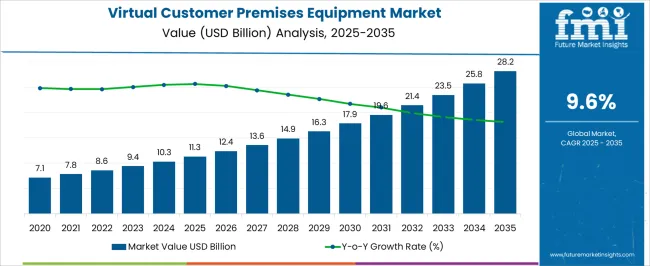
| Metric | Value |
|---|---|
| Virtual Customer Premises Equipment Market Estimated Value in (2025 E) | USD 11.3 billion |
| Virtual Customer Premises Equipment Market Forecast Value in (2035 F) | USD 28.2 billion |
| Forecast CAGR (2025 to 2035) | 9.6% |
The Virtual Customer Premises Equipment market is expanding rapidly, fueled by the increasing shift from hardware-based networking solutions toward virtualized platforms that deliver scalability, flexibility, and cost efficiency. Enterprises are increasingly adopting vCPE solutions to centralize network functions and reduce capital and operational expenditures while enhancing agility in service deployment. The growing demand for software-defined networking and network functions virtualization is further strengthening adoption.
Managed service providers and telecom operators are deploying vCPE to support dynamic workloads, multi-cloud connectivity, and secure enterprise communications. The rising adoption of cloud-native applications and edge computing is enabling service optimization, while over-the-air software updates reduce reliance on expensive hardware replacements. Enhanced interoperability with third-party platforms, combined with greater customization capabilities, is shaping the competitive landscape.
Regulatory compliance, cybersecurity concerns, and the need for faster provisioning of digital services are encouraging enterprises to integrate vCPE solutions into their IT ecosystems As organizations continue digital transformation initiatives and accelerate adoption of flexible network infrastructures, the Virtual Customer Premises Equipment market is expected to experience robust and sustained growth over the forecast period.
The virtual customer premises equipment market is segmented by solution, service, service model, end-user, industry application, and geographic regions. By solution, virtual customer premises equipment market is divided into Virtual Routers, Virtual Switches, Controller And Application Platform, Orchestration And Infrastructure Management, and Compliance And Security. In terms of service, virtual customer premises equipment market is classified into Managed Service and Professional Service. Based on service model, virtual customer premises equipment market is segmented into Platform As A Service (PaaS), Infrastructure As A Service (IaaS), and Others. By end-user, virtual customer premises equipment market is segmented into Small Enterprises, Medium Enterprises (SMEs), and Large Enterprises. By industry application, virtual customer premises equipment market is segmented into Banking, Financial Services And Insurance (BFSI), IT And Telecommunication, Energy And Utility, Government Offices And Education, Healthcare, and Others. Regionally, the virtual customer premises equipment industry is classified into North America, Latin America, Western Europe, Eastern Europe, Balkan & Baltic Countries, Russia & Belarus, Central Asia, East Asia, South Asia & Pacific, and the Middle East & Africa.
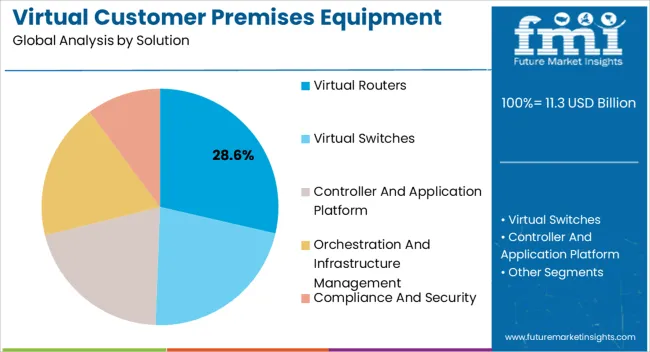
The virtual routers solution segment is projected to hold 28.6% of the market revenue share in 2025, positioning it as the leading solution type. Growth in this segment is being driven by the increasing enterprise demand for scalable, software-based routing functions that eliminate the need for costly proprietary hardware. Virtual routers support dynamic scalability, multi-protocol routing, and seamless integration with cloud and hybrid networks, making them highly adaptable for modern enterprise connectivity requirements.
The segment is benefiting from advancements in network functions virtualization and software-defined networking, which provide centralized management and flexibility in service deployment. Enterprises are leveraging virtual routers to optimize bandwidth, reduce latency, and ensure cost-efficient delivery of network services. Their compatibility with multi-cloud environments and ability to handle increasing data traffic are further accelerating adoption.
By enabling over-the-air updates and reducing hardware dependency, virtual routers are delivering long-term operational savings As enterprises prioritize cloud-first strategies and service providers expand network virtualization initiatives, the virtual routers solution segment is expected to maintain its leadership position in the global market.
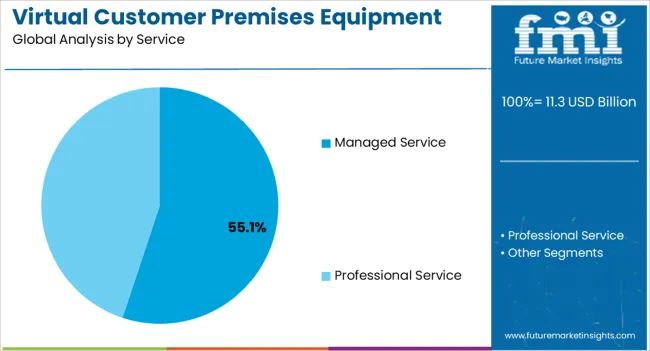
The managed service segment is anticipated to account for 55.1% of the Virtual Customer Premises Equipment market revenue in 2025, making it the leading service category. Growth in this segment is supported by the rising enterprise need for outsourced management of complex network infrastructures, enabling organizations to focus on core business operations while reducing IT overheads. Managed service providers deliver continuous monitoring, configuration, and optimization of vCPE solutions, ensuring performance consistency and regulatory compliance.
Increasing complexity in hybrid and multi-cloud environments is reinforcing demand for managed services, where expertise in network virtualization and security is critical. Enterprises are leveraging managed services to achieve faster deployment of virtualized network functions and to maintain cost predictability through subscription-based models.
Integration with cloud platforms, advanced security features, and support for remote workforce connectivity are additional factors driving segment growth As enterprises face growing challenges in managing expanding digital infrastructures, the managed service segment is expected to remain dominant, offering reliability, scalability, and efficiency in delivering virtualized network solutions.
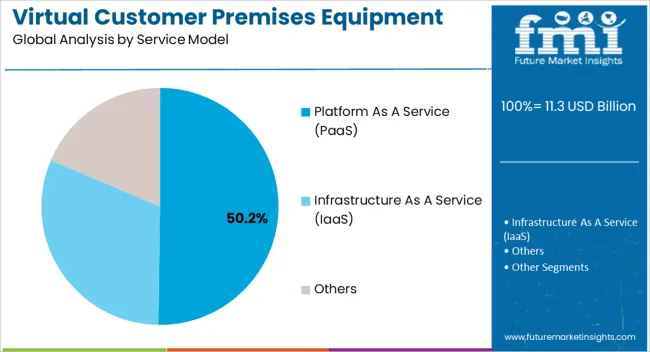
The platform as a service model segment is expected to capture 50.2% of the Virtual Customer Premises Equipment market revenue share in 2025, making it the leading service model. Its growth is being driven by increasing enterprise reliance on PaaS for rapid application deployment, scalability, and integration with virtualized networking functions. PaaS enables businesses to build, test, and manage applications without investing in extensive hardware or software infrastructure, thereby accelerating time to market.
The segment benefits from its strong compatibility with vCPE solutions, supporting seamless network function virtualization and cloud-native application delivery. Enterprises are adopting PaaS to achieve agility, reduce operational costs, and enable dynamic scaling of services in response to fluctuating workloads. Continuous innovation in orchestration tools, AI-driven automation, and security integration is further strengthening the appeal of this model.
As organizations accelerate digital transformation initiatives, the demand for PaaS-driven vCPE deployments is rising With strong alignment to cloud-first strategies and enterprise requirements for flexible platforms, the PaaS model segment is expected to dominate market revenues throughout the forecast period.
For past couple of years, gradual shift from hardware to software has been witnessed by various organizations owing to the increased network flexibility. The software that offers network services includes virtual private network connectivity, firewall security, and routing.
This methodology of delivering network services through software is termed as virtual customer premises equipment (VCPE). The virtual infrastructure enables enterprises to reduce organizations’ dependency on hardware. This virtual infrastructure also aids organizations to minimize the cost of networking infrastructure.
Virtual customer premises equipment offers updated physical networking infrastructure that can be changed into sharable virtual resources and can be accessible from anywhere. Remote deployment in case of virtual customer premises equipment is among the prime advantages over the traditional hardware based solutions.
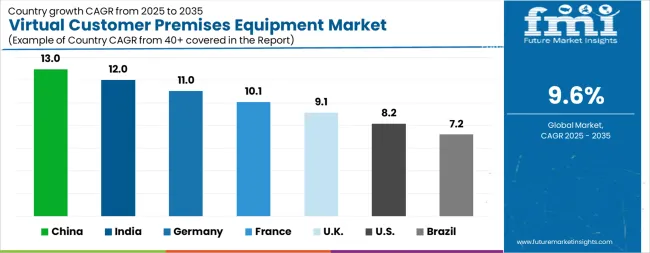
| Country | CAGR |
|---|---|
| China | 13.0% |
| India | 12.0% |
| Germany | 11.0% |
| France | 10.1% |
| UK | 9.1% |
| USA | 8.2% |
| Brazil | 7.2% |
The Virtual Customer Premises Equipment Market is expected to register a CAGR of 9.6% during the forecast period, exhibiting varied country level momentum. China leads with the highest CAGR of 13.0%, followed by India at 12.0%. Developed markets such as Germany, France, and the UK continue to expand steadily, while the USA is likely to grow at consistent rates. Brazil posts the lowest CAGR at 7.2%, yet still underscores a broadly positive trajectory for the global Virtual Customer Premises Equipment Market. In 2024, Germany held a dominant revenue in the Western Europe market and is expected to grow with a CAGR of 11.0%. The USA Virtual Customer Premises Equipment Market is estimated to be valued at USD 3.9 billion in 2025 and is anticipated to reach a valuation of USD 8.6 billion by 2035. Sales are projected to rise at a CAGR of 8.2% over the forecast period between 2025 and 2035. While Japan and South Korea markets are estimated to be valued at USD 593.3 million and USD 352.9 million respectively in 2025.
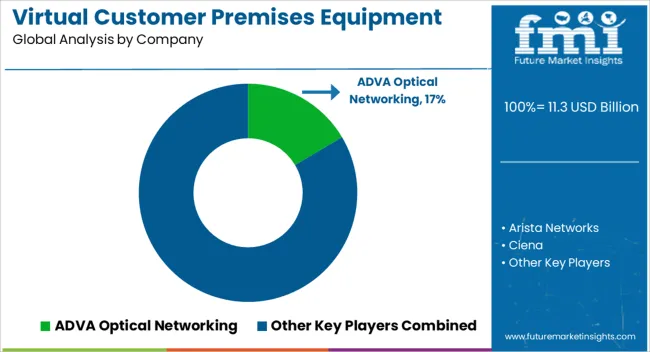
| Item | Value |
|---|---|
| Quantitative Units | USD 11.3 Billion |
| Solution | Virtual Routers, Virtual Switches, Controller And Application Platform, Orchestration And Infrastructure Management, and Compliance And Security |
| Service | Managed Service and Professional Service |
| Service Model | Platform As A Service (PaaS), Infrastructure As A Service (IaaS), and Others |
| End-User | Small Enterprises, Medium Enterprises (SMEs), and Large Enterprises |
| Industry Application | Banking, Financial Services And Insurance (BFSI), IT And Telecommunication, Energy And Utility, Government Offices And Education, Healthcare, and Others |
| Regions Covered | North America, Europe, Asia-Pacific, Latin America, Middle East & Africa |
| Country Covered | United States, Canada, Germany, France, United Kingdom, China, Japan, India, Brazil, South Africa |
| Key Companies Profiled | ADVA Optical Networking, Arista Networks, Ciena, Cisco Systems, Ericsson, Hewlett Packard Enterprise, Juniper Networks, NEC, Versa Networks, and VMware |
The global virtual customer premises equipment market is estimated to be valued at USD 11.3 billion in 2025.
The market size for the virtual customer premises equipment market is projected to reach USD 28.2 billion by 2035.
The virtual customer premises equipment market is expected to grow at a 9.6% CAGR between 2025 and 2035.
The key product types in virtual customer premises equipment market are virtual routers, virtual switches, controller and application platform, orchestration and infrastructure management and compliance and security.
In terms of service, managed service segment to command 55.1% share in the virtual customer premises equipment market in 2025.






Our Research Products

The "Full Research Suite" delivers actionable market intel, deep dives on markets or technologies, so clients act faster, cut risk, and unlock growth.

The Leaderboard benchmarks and ranks top vendors, classifying them as Established Leaders, Leading Challengers, or Disruptors & Challengers.

Locates where complements amplify value and substitutes erode it, forecasting net impact by horizon

We deliver granular, decision-grade intel: market sizing, 5-year forecasts, pricing, adoption, usage, revenue, and operational KPIs—plus competitor tracking, regulation, and value chains—across 60 countries broadly.

Spot the shifts before they hit your P&L. We track inflection points, adoption curves, pricing moves, and ecosystem plays to show where demand is heading, why it is changing, and what to do next across high-growth markets and disruptive tech

Real-time reads of user behavior. We track shifting priorities, perceptions of today’s and next-gen services, and provider experience, then pace how fast tech moves from trial to adoption, blending buyer, consumer, and channel inputs with social signals (#WhySwitch, #UX).

Partner with our analyst team to build a custom report designed around your business priorities. From analysing market trends to assessing competitors or crafting bespoke datasets, we tailor insights to your needs.
Supplier Intelligence
Discovery & Profiling
Capacity & Footprint
Performance & Risk
Compliance & Governance
Commercial Readiness
Who Supplies Whom
Scorecards & Shortlists
Playbooks & Docs
Category Intelligence
Definition & Scope
Demand & Use Cases
Cost Drivers
Market Structure
Supply Chain Map
Trade & Policy
Operating Norms
Deliverables
Buyer Intelligence
Account Basics
Spend & Scope
Procurement Model
Vendor Requirements
Terms & Policies
Entry Strategy
Pain Points & Triggers
Outputs
Pricing Analysis
Benchmarks
Trends
Should-Cost
Indexation
Landed Cost
Commercial Terms
Deliverables
Brand Analysis
Positioning & Value Prop
Share & Presence
Customer Evidence
Go-to-Market
Digital & Reputation
Compliance & Trust
KPIs & Gaps
Outputs
Full Research Suite comprises of:
Market outlook & trends analysis
Interviews & case studies
Strategic recommendations
Vendor profiles & capabilities analysis
5-year forecasts
8 regions and 60+ country-level data splits
Market segment data splits
12 months of continuous data updates
DELIVERED AS:
PDF EXCEL ONLINE
Virtual Land NFT Market Size and Share Forecast Outlook 2025 to 2035
Virtual Pipeline Market Size and Share Forecast Outlook 2025 to 2035
Customer Service Software Market Size and Share Forecast Outlook 2025 to 2035
Customer Revenue Optimization (CRO) Software Market Size and Share Forecast Outlook 2025 to 2035
Virtual Infrastructure Manager Market Size and Share Forecast Outlook 2025 to 2035
Virtual Companion Care Market Size and Share Forecast Outlook 2025 to 2035
Virtualized Radio Access Network Market Size and Share Forecast Outlook 2025 to 2035
Virtual Workspace Solutions Market Size and Share Forecast Outlook 2025 to 2035
Customer Communications Management Market Size and Share Forecast Outlook 2025 to 2035
Virtual Prototype Market Size and Share Forecast Outlook 2025 to 2035
Virtual Assistant Services Market Size and Share Forecast Outlook 2025 to 2035
Virtual Power Plant (VPP) and V2G Orchestration Market Analysis - Size, Share, and Forecast Outlook 2025 to 2035
Virtual Power Plant Market Size and Share Forecast Outlook 2025 to 2035
Equipment Management Software Market Size and Share Forecast Outlook 2025 to 2035
Virtual Machines Market by Type, by Enterprise Size, by Industry & Region Forecast till 2035
Virtual Extensible LAN (VXLAN) Market Size and Share Forecast Outlook 2025 to 2035
Virtual Private Cloud Market Size and Share Forecast Outlook 2025 to 2035
Virtual PLC and Soft PLC Market Size and Share Forecast Outlook 2025 to 2035
Equipment cases market Size and Share Forecast Outlook 2025 to 2035
Customer Experience Management (CEM) In Telecommunication Market Size and Share Forecast Outlook 2025 to 2035

Thank you!
You will receive an email from our Business Development Manager. Please be sure to check your SPAM/JUNK folder too.
Chat With
MaRIA